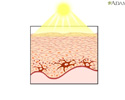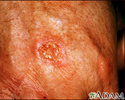Skin cancer
Cancer - skinSkin cancer is usually a result of too much sun exposure. Skin cancer is the most common form of cancer. Many types of skin cancer are both preventable and treatable. There are 5 different types of skin cancer:Basal cell carcinoma is the most common form, accounting for 90% of all skin cancers. It starts in the basal cells, at the bottom of...
The Basics
Tests for skin cancer
A Closer Look
Sun's effect on skin - Animation
Sun's effect on skin
Animation
Melanoma - Animation
Melanoma
Animation
Skin cancer, close-up of lentigo maligna melanoma
Increased risk for skin cancer, especially melanoma, is associated with chronic exposure to sunlight, blistering sunburns, and a family history of skin cancer.
Skin cancer, close-up of lentigo maligna melanoma
illustration
Skin cancer - squamous cell on the hands
This is a picture of squamous cell skin cancer on the hands. Squamous cell carcinoma is one of the three most common types of skin cancer: basal cell, squamous cell, and melanoma. Squamous cell cancers can metastasize (spread) and should be removed surgically as soon as they are diagnosed.
Skin cancer - squamous cell on the hands
illustration
Skin cancer, basal cell carcinoma - pigmented
This skin cancer appears as a 2 to 3 centimeter skin spot. The tissue has become destroyed (forming an atrophic plaque). There is a brownish color because of increased skin pigment (hyperpigmentation) and a slightly elevated, rolled, pearl-colored margin. This growth is located along the hair line.
Skin cancer, basal cell carcinoma - pigmented
illustration
Skin cancer, basal cell carcinoma - spreading
This skin cancer, a basal cell carcinoma, is 5 to 6 centimeters across, red (erythematous), with well defined (demarcated) borders and sprinkled brown pigment along the margins. This cancer is located on the person's back.
Skin cancer, basal cell carcinoma - spreading
illustration
Skin cancer, basal cell carcinoma - behind ear
This skin cancer appears as a 1 to 1. 5 centimeter flesh-colored nodule with a central depression and a raised, pearly border. Small blood vessels are visible (telangiectatic).
Skin cancer, basal cell carcinoma - behind ear
illustration
Skin cancer, squamous cell - close-up
Squamous cell carcinoma is one of the three most common types of skin cancer: basal cell, squamous cell, and melanoma. Squamous cell cancers can metastasize (spread) and should be removed surgically as soon as they are diagnosed.
Skin cancer, squamous cell - close-up
illustration
Skin cancer, basal cell carcinoma - nose
The typical basal cell skin cancer appears as a small, pearly, dome-shaped nodule with small visible blood vessels (telangiectasias).
Skin cancer, basal cell carcinoma - nose
illustration
Skin cancer, melanoma on the fingernail
Malignant melanoma is the most dangerous type of skin cancer. Melanomas beneath the fingernail appear as a black or bluish black discoloration. This type of malignancy spreads (metastasizes) readily.
Skin cancer, melanoma on the fingernail
illustration
Skin cancer - close-up of level III melanoma
Malignant melanoma is the most dangerous type of the skin cancers. Typical features of melanomas include irregular borders, multiple colors within the lesion, rapid growth, and susceptibility to easy injury with bleeding. Any mole that exhibits any of these changes should be evaluated immediately by your physician.
Skin cancer - close-up of level III melanoma
illustration
Skin cancer - close-up of level IV melanoma
Malignant melanoma is the most dangerous type of the skin cancers. Typical features of melanomas include irregular borders, multiple colors within the lesion, rapid growth, and susceptibility to easy injury with bleeding. Any mole that exhibits any of these changes should be evaluated immediately by your physician.
Skin cancer - close-up of level IV melanoma
illustration
Sun's effect on skin - Animation
Sun's effect on skin
Animation
Melanoma - Animation
Melanoma
Animation
Skin cancer, close-up of lentigo maligna melanoma
Increased risk for skin cancer, especially melanoma, is associated with chronic exposure to sunlight, blistering sunburns, and a family history of skin cancer.
Skin cancer, close-up of lentigo maligna melanoma
illustration
Skin cancer - squamous cell on the hands
This is a picture of squamous cell skin cancer on the hands. Squamous cell carcinoma is one of the three most common types of skin cancer: basal cell, squamous cell, and melanoma. Squamous cell cancers can metastasize (spread) and should be removed surgically as soon as they are diagnosed.
Skin cancer - squamous cell on the hands
illustration
Skin cancer, basal cell carcinoma - pigmented
This skin cancer appears as a 2 to 3 centimeter skin spot. The tissue has become destroyed (forming an atrophic plaque). There is a brownish color because of increased skin pigment (hyperpigmentation) and a slightly elevated, rolled, pearl-colored margin. This growth is located along the hair line.
Skin cancer, basal cell carcinoma - pigmented
illustration
Skin cancer, basal cell carcinoma - spreading
This skin cancer, a basal cell carcinoma, is 5 to 6 centimeters across, red (erythematous), with well defined (demarcated) borders and sprinkled brown pigment along the margins. This cancer is located on the person's back.
Skin cancer, basal cell carcinoma - spreading
illustration
Skin cancer, basal cell carcinoma - behind ear
This skin cancer appears as a 1 to 1. 5 centimeter flesh-colored nodule with a central depression and a raised, pearly border. Small blood vessels are visible (telangiectatic).
Skin cancer, basal cell carcinoma - behind ear
illustration
Skin cancer, squamous cell - close-up
Squamous cell carcinoma is one of the three most common types of skin cancer: basal cell, squamous cell, and melanoma. Squamous cell cancers can metastasize (spread) and should be removed surgically as soon as they are diagnosed.
Skin cancer, squamous cell - close-up
illustration
Skin cancer, basal cell carcinoma - nose
The typical basal cell skin cancer appears as a small, pearly, dome-shaped nodule with small visible blood vessels (telangiectasias).
Skin cancer, basal cell carcinoma - nose
illustration
Skin cancer, melanoma on the fingernail
Malignant melanoma is the most dangerous type of skin cancer. Melanomas beneath the fingernail appear as a black or bluish black discoloration. This type of malignancy spreads (metastasizes) readily.
Skin cancer, melanoma on the fingernail
illustration
Skin cancer - close-up of level III melanoma
Malignant melanoma is the most dangerous type of the skin cancers. Typical features of melanomas include irregular borders, multiple colors within the lesion, rapid growth, and susceptibility to easy injury with bleeding. Any mole that exhibits any of these changes should be evaluated immediately by your physician.
Skin cancer - close-up of level III melanoma
illustration
Skin cancer - close-up of level IV melanoma
Malignant melanoma is the most dangerous type of the skin cancers. Typical features of melanomas include irregular borders, multiple colors within the lesion, rapid growth, and susceptibility to easy injury with bleeding. Any mole that exhibits any of these changes should be evaluated immediately by your physician.
Skin cancer - close-up of level IV melanoma
illustration
Skin cancer
Cancer - skinSkin cancer is usually a result of too much sun exposure. Skin cancer is the most common form of cancer. Many types of skin cancer are both preventable and treatable. There are 5 different types of skin cancer:Basal cell carcinoma is the most common form, accounting for 90% of all skin cancers. It starts in the basal cells, at the bottom of...
The Basics
Tests for skin cancer
A Closer Look
Skin cancer
Cancer - skinSkin cancer is usually a result of too much sun exposure. Skin cancer is the most common form of cancer. Many types of skin cancer are both preventable and treatable. There are 5 different types of skin cancer:Basal cell carcinoma is the most common form, accounting for 90% of all skin cancers. It starts in the basal cells, at the bottom of...
The Basics
Tests for skin cancer
A Closer Look
Review Date: 12/19/2015
Reviewed By: Steven D. Ehrlich, NMD, Solutions Acupuncture, a private practice specializing in complementary and alternative medicine, Phoenix, AZ. Review provided by VeriMed Healthcare Network.













